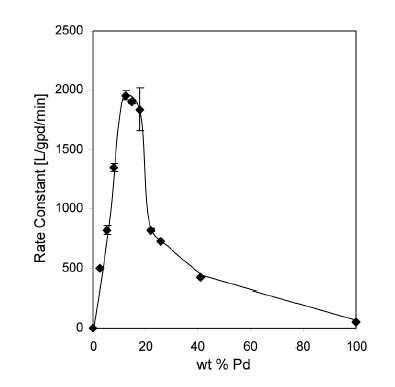Heterogeneous Catalysis for Water Remediation.
Groundwater remediation through the catalytic breakdown of the undesired contaminants is a more effective and desirable approach than the conventional physical displacement methods of air-stripping and carbon adsorption. Palladium (Pd) catalysts are known to catalyze the hydrodechlorination (HDC) of trichloroethene (TCE) in water, at room temperature, and in the presence of hydrogen. TCE is one of the most common organic pollutants in US groundwaters today. Mostly used as a solvent to degrease metal parts in a number of industries and at numerous Department of Energy and Department of Defense facilities, it contaminates 60% of Superfund sites at concentration levels that far exceed the current EPA maximum contaminant level of 5 ppb. TCE is also one of the most hazardous pollutants, as it has been found to cause liver and kidney damage and is suspected to be a carcinogen.
We recently discovered that palladium-on-gold nanoparticles (Pd/Au NPs) can be >70 times more active than Pd supported on alumina on a per-Pd gram basis, and are currently working towards understanding the source of the catalytic enhancement and towards improving the potential of this catalyst as a groundwater remediation technology. We synthesized Pd/Au NPs with a core diameter of 4 nm and with different Pd loadings. The most active catalysts were considerably more active (1956 L/gPd/min) than Pd NPs (54 L/gPd/min) and conventionally synthesized Pd/Al2O3 (47 L/gPd/min). Accounting for a gas-liquid mass transfer effect and for the magic-cluster-like core/shell geometry, the reaction rates in terms of initial turnover frequencies were 1.43, 4.35 x 10-2, and 3.76 x 10-2 s-1, respectively. These materials exhibited a volcano-shaped activity vs. Pd surface coverage curve, in which the HDC activity peaked near 70% surface coverage.
These NPs can be immobilized on alumina, magnesia, and silica supports to yield active oxide-supported catalysts. This effort, in collaboration with environmental engineers, will lead to an engineered treatment system that can be studied for long-term operational stability and efficacy for remediation of other oxidized water pollutants. Such a system is envisioned to replace the thousands of existing, but aging, pump-and-treat systems throughout the United States.

TCE HDC reaction rate constants of Pd/Au NPs (4-nm Au NPs) plotted against Pd loadings (on metals basis)
Selected Publications
K. N. Heck, M. O. Nutt, P. Alvarez, and M. S. Wong, "Deactivation Resistance of Pd/Au Nanoparticle Catalysts for Water-phase Hydrodechlorination", J. Catal. 267, 97-104 (2009)DOI:10.1016/j.jcat.2009.07.015 (Abstract)
M. S. Wong, P. J.J. Alvarez, Y.L. Fang, N. Akcin, M. O. Nutt, J. T. Miller, and K. N. Heck, "Cleaner Water using Bimetallic Nanoparticle Catalysts" J. Chem. Tech.; Biotech, 84, 158-166 (2009). DOI:10.1002/jctb.2002 (Abstract)
M. O. Nutt, K. N. Heck, P. Alvarez, and M. S. Wong, "Improved Pd-on-Au Bimetallic Nanoparticle Catalysts for Aqueous-phase Trichloroethene Hydrodechlorination:,Appl. Catal. B Env. 69, 115-125 (2006). DOI:10.1016/j.apcatb.2006.06.005 (Abstract)
M. O. Nutt, J. B. Hughes and M. S. Wong, "Designing Pd-on-Au Bimetallic Nanoparticle Catalysts for Trichloroethene Hydrodechlorination",Environ. Sci.Technol. 39, 1346 - 1353 (2005). DOI:10.1021/es048560b (Abstract)